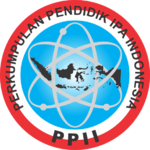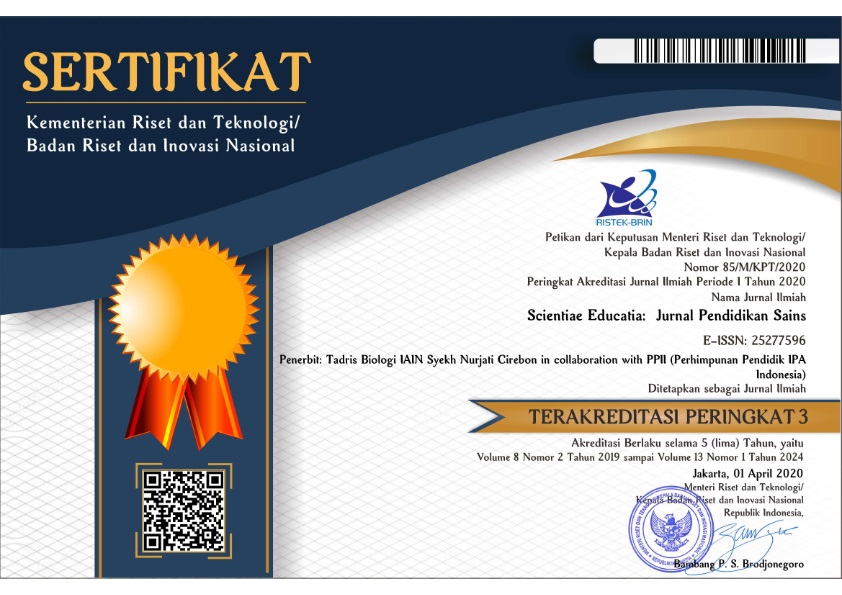The Profile of Students’ Analytical Thinking Skills on Chemistry Systemic Learning Approach
(1) Department of Chemistry Education, Faculty of Mathematics and Natural Sciences, Universitas Negeri Yogyakarta
(2) Department of Chemistry Education, Faculty of Mathematics and Natural Sciences, Universitas Negeri Yogyakarta
(3) Department of Chemistry Education, Faculty of Mathematics and Natural Sciences, Universitas Negeri Yogyakarta
(*) Corresponding Author
Abstract
Keywords
Full Text:
PDFReferences
Anderson, L. W., & Krathwohl, D. R. (2001). A Taxonomy for Learning, Teaching, and Assessing. New York, NY: Longman.
Areesophonpichet, S. (2013). A development of analytical thinking skills of graduate students. The Asian Conference on Education (pp. 1-5). Osaka, Japan: The International Academic Forum
Art-In., & Sitthipon. (2012). Development of teachers’ learning management emphasizing on analytical thinking in Thailand. Procedia Social and Behavioral Sciences, 46, 3339–3344. http://dx.doi.org/10.1016/j.sbspro.2012.06.063
Awad, B. M. (2017). Attractive educational strategies in teaching and learning chemistry. African Journal of Chemical Education, 7(3), 82-97. https://www.ajol.info/index.php/ajce/article/view/162212
Bashaireh, Z. A. (2011). Systemic approach effect on achievement of Tafila schools’ students in science. International Journal of Humanities and Social Science, 3(1), 47-52. http://www.ijhssnet.com/journals/Vol._1_No._3;_March_2011/7.pdf
Fahmy, A. F. M. (2017). The systemic approach to teaching and learning chemistry (SATLC): A 20-years review. African Journal of Chemical Education, 7(3), 2-44. http://www.satlcentral.com/
Fahmy, A. F. M., & Lagowski, J. J. (1999) The use of a systemic approach in teaching and learning chemistry for the 21st century. Pure Appl. Chem. 71(5), 859-863. http://dx.doi.org/10.1351/pac199971050859
Fahmy, A., & Lagowski, J. (2011). The systemic approaches to teaching and learning [SATL]: a 10-Year Review. African Journal of Chemical Education, 1(1), 29-47. http://www.faschem.org/AJCE/AJCE_2011_January.pdf
Fahmy, A., & Said, A. (2011). The systemic approach to teaching and learning: Water chemistry. African Journal of Chemical Education, 1(2), 50-58. https://www.ajol.info/index.php/ajce/article/view/82529
Fitriyana, N., Wiyarsi, A., & Sugiyarto, K. H. (2018). The profile of students’ self-efficacy on hydrocarbon hybrid learning and android-based-game. International Journal of New Trends in Education and Their Implications, 9(2), 1-15. http://www.ijonte.org/FileUpload/ks63207/File/01a.nur_fitriyana.pdf
Fitriyana, N., Wiyarsi, A., Ikhsan, J., & Sugiyarto, K. H. (2018). Fostering of students’ self-regulated learning and achievement: A study on hydrocarbon hybrid-learning and android-based-game. J. Phys.: Conf. Ser., 1097, 012064. http://dx.doi.org/10.1088/1742-6596/1097/1/012064
George, D., & Mallery, P. (2003). SPSS for windows step by step: A simple guide and reference. 11.0 update (4th ed.). Boston: Allyn & Bacon.
Golemi, S. B. (2017). Implementation of the systemic approach in teaching and learning biochemistry in Albania. African Journal of Chemical Education, 7(3), 98-117. http://www.faschem.org/AJCE/AJCE_2017_October_Special.pdf
Hake, R. R. (1998). Interactive-engagement versus traditional methods: A six-thousand-student survey of mechanics’ test data for introductory physics course. American Journal of Physics, 66(1), 64-74. http://dx.doi.org/10.1119/1.18809
Hrin, T. N., Milenković, D. D., & Segedinac, M. D. (2015). The effect of systemic synthesis questions [SSynQs] on students’ performance and meaningful learning in secondary organic chemistry teaching. Int J of Sci and Math Educ, 14(5), 805-824. doi:10.1007/s10763-015-9620-y
Hrin, T. N., Milenković, D. D., & Segedinac, M. D. (2017). Examining systems thinking through the application of systemic approach in the secondary school chemistry teaching. African Journal of Chemical Education, 7(3), 66-81. http://www.faschem.org/AJCE/AJCE_2017_October_Special.pdf
Hrin, T. N., Milenković, D. D., Segedinac, M. D., Horvat, S. (2016). Enhancement and assessment of students’ systems thinking skills by application of systemic synthesis questions in the organic chemistry course. J. Serb. Chem. Soc. 81(12) 1455–1471. doi: 10.2298/JSC160811097H
Marfuatun, & Hardiningtyas, R. F. (2018). Development of website teaching materials based on systemic approach in thermochemistry. J. Phys.: Conf. Ser., 1097, 012063. doi: 10.1088/1742-6596/1097/1/012063
Marfuatun, Fillaeli, A., & Yuanita, D. (2014, November) The implementation of systemic approach based on contextual learning to improve the student's understanding of concept and scientific process skill in experiment of physical chemistry II. Paper presented in National Chemistry Conference, Yogyakarta.
Mayer, R. E. (2002). Rote versus meaningful learning. Theory into Practice, 41(4), 226-232. doi: 10.1207/s15430421tip4104_4
Naqvi, I. I., Summer, S., Kanwal, G., & Hasnat, S. (2017). SATL based lesson for teaching metabolism in biochemistry. African Journal of Chemical Education, 7(3), 57-65. http://www.faschem.org/AJCE/AJCE_2017_October_Special.pdf
Petrovska, S., & Veselinovska, S. S. (2013). Contemporary pedagogical approaches for developing higher level thinking on science classes. Procedia – Social and Behavioral Sciences, 92, 702-710. doi: 10.1016/j.sbspro.2013.08.72
Priyambodo, E., & Marfuatun. (2016). Validity and reliability of chemistry systemic multiple choices questions (CSMCQs). International Journal of Evaluation and Research in Education, 5(4), 306-309. http://iaesjournal.com/online/index.php/IJERE
Putri, A. S., & Aznam, N. (2019). The effectiveness of science learning media using focusky software on junior high school students’ higher order thinking skills. Scientiae Educatia: Jurnal Pendidikan Sains, 8(1), 12-22. http://dx.doi.org/10.24235/sc.educatia.v8i1.3886
Ramirez, R. P. B., & Ganaden, M. S. (2008). Creative activities and students’ higher order thinking skills. Education Quarterly, 66(1), 22-33. doi: 10.1.1.824.9279
Rutledge, J. J. (2006). Analytical reasoning: A tool for life.
Sinlarat, P. (2000). Weak point of academic work in thai higher education system. Higher Education, 26(261), 14-17.
Sirhan, G. (2007). Learning Difficulties in Chemistry: an Overview. Journal of Turkish Science Education, 4, 2-20. http://www.tused.org/internet/tufed/arsiv/v4/i2/metin/tusedv4i2s1.pdf
Suyanta, Marfuatun, & Widjajanti, E. (2013) The application of systemic learning approach to increase the understanding of student concept in general chemistry 1. Jurnal Pendidikan Matematika dan Sains, 1(1), 54-59. https://media.neliti.com/media/publications/122997-ID-penerapan-pendekatan-pembelajaran-sistem.pdf
Taleb, D. M., & Chadwick, C. (2016). Enhancing student critical and analytical thinking skills at a higher education level in developing countries: case study of the british university in dubai. Journal of Educational and Instructional Studies, 6(1), 67-77. http://www.wjeis.org/FileUpload/ds217232/File/8.hanan_m._taleb.pdf
Thaneerananon, T., Triampo, W., & Nokkaew, A. (2016). Development of a test to evaluate students’ analytical thinking based on fact versus opinion differentiation. International Journal of Instruction, 9(2), 123-138. doi: 10.12973/iji.2016.929a
Wiyarsi, A., Fitriyana, N., & Ikhsan, J. (2019). Using technology in hydrocarbon topics: A profile on students’ self-regulated learning. Journal for the Education of Gifted Young Scientists, 7(4), 961-972. http://dx.doi.org/10.17478/jegys.2018.82
DOI: 10.24235/sc.educatia.v8i2.5272
Article Metrics
Abstract view : 253 timesPDF - 107 times
Refbacks
- There are currently no refbacks.
Scientiae Educatia: Jurnal Pendidikan Sains indexed by:

This work is licensed under a Creative Commons Attribution 4.0 International License.
Stat Counter (Link)



1.png)












